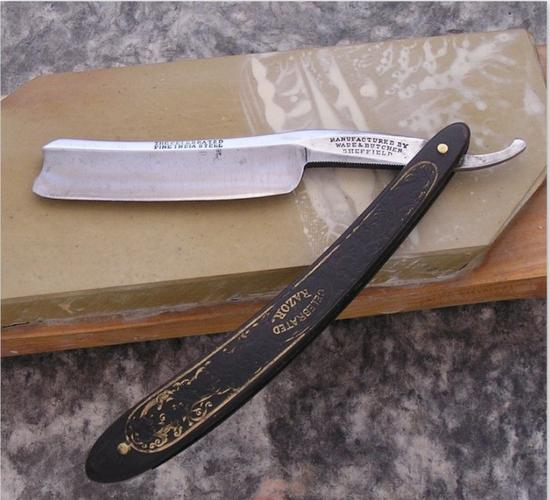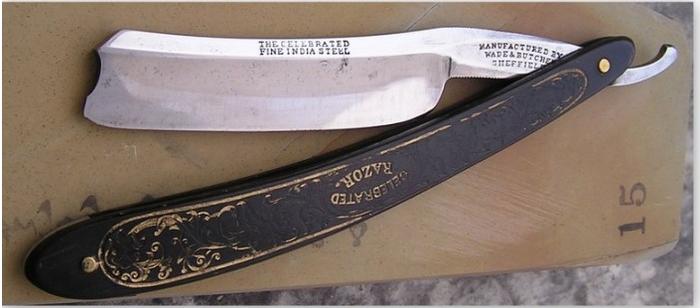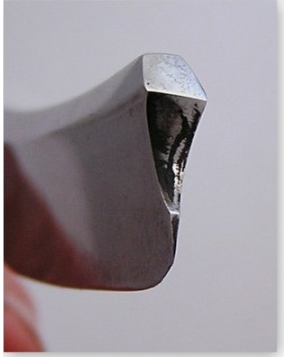Results 1 to 10 of 13
Thread: Wade & Butcher India Steel
-
06-16-2013, 06:22 PM #1Member

- Join Date
- May 2013
- Location
- Dubai
- Posts
- 56
Thanked: 2 Wade & Butcher India Steel
Wade & Butcher India Steel
Just received my Wade&Butcher razor. As far as I understand it is pre 1890, as the stamp has no mention of 'England'. Anyways, as this is my first vintage razor, moreover my first razor which is not a Dovo, I am still trying to figure out how to approach this animal

Below are the snaps done by the seller and because they do justice, I decided to use them here. There is almost no hone wear, just as much as on my brand new Dovo razors that were pro-sharpened by the vendors. The blade itself is quite shiny, but does not seem to be polished. It looks like the razor was not used much at all. Bevel on both sides is quite narrow and even in width on both sides. Scales seem to be wood, but I am not sure at all... did they use wood for scales back then, or only horn??
The pin which holds the blade is tight when I move the blade all the way up, but holding the scales with blade down causes it to open up. I don't know if this is normal, but with a heavy blade like this I guess it is.
Third, I am trying to understand if this is a near wedge or not. Opinions on this will be much appreciated.
And finally, when I put it down on the hone (I did not hone yet, just put it on the stone) the blade touches the stone along the entire edge, so I guess rolling x is not needed here. Any tips, links to videos or other material in regards to honing this blade will also be much appreciated.
Thank you!!!) I am excited at the prospect of shaving with a legendary instrument like this which is at least 123 yo. (seller says it is from 1860-70)
I am excited at the prospect of shaving with a legendary instrument like this which is at least 123 yo. (seller says it is from 1860-70)



-
06-16-2013, 06:47 PM #2Poor Fit

- Join Date
- May 2010
- Posts
- 4,562
Thanked: 1263
You've got yourself a fine looking razor there! The scales are most likely horn on that beauty. Hone it up and enjoy

-
The Following User Says Thank You to Catrentshaving For This Useful Post:
Cros (06-16-2013)
-
06-16-2013, 06:51 PM #3Member

- Join Date
- May 2013
- Location
- Dubai
- Posts
- 56
Thanked: 2
-
06-16-2013, 06:53 PM #4Poor Fit

- Join Date
- May 2010
- Posts
- 4,562
Thanked: 1263
Because there is a smile to the blade, the rolling x stroke is probably the way you'll want to go

-
The Following User Says Thank You to Catrentshaving For This Useful Post:
Cros (06-16-2013)
-
06-16-2013, 06:57 PM #5

I have a few of these razors myself, each is in my rotation. The are made of excellent period steel, set to a proper temper. The wedge grind is going to be a nice variation from your likely hollow dovos. This is a great razor... Enjoy it!
......... Making Old Razors Shine N' Shave, Once Again.
-"Sheffield Style"
-
The Following User Says Thank You to JoeLowett For This Useful Post:
Cros (06-16-2013)
-
06-16-2013, 07:40 PM #6

That is wicked beautiful, enjoy. Honing -- tape it, try the magic marker test, be prepared to put on a second layer of tape. You'll almost certainly need to learn a good rolling-x stroke, likely with a heel-leading "swoop" besides.
-
06-16-2013, 07:48 PM #7Member

- Join Date
- May 2013
- Location
- Dubai
- Posts
- 56
Thanked: 2
-
06-19-2013, 12:55 PM #8Senior Member

- Join Date
- Dec 2012
- Location
- Melbourne, VIC, Australia
- Posts
- 352
Thanked: 28
That razor is awesome! I really want one now, I just won a 7/8 WnB india steel but I really love this one, love the deep stamp along the spine and the scales too.
"In the words of the ancients, one should make his decisions within the space of seven breaths." Yamamoto Tsunetomo
-
06-19-2013, 01:44 PM #9
-
06-19-2013, 02:38 PM #10Senior Member

- Join Date
- May 2013
- Location
- Berlin, Germany
- Posts
- 286
Thanked: 39
Beautiful razor, take Your time with it.
Before You hone it, I would check how sharp it actually is. The vendor's pictues show it laying on a stone with some slurry, so it might actually be honed and ready to use.
If it is not obviously dull, strop it and try to shave with it in order to see what You actually got there. This is an old, historic blade in a great state and any metal that You unnecessarily take off is wasted.
You've got a smiling edge there and contact with the stone alone is only one thing. Another aspect is the angle between edge and stone. with a straight straight You can pull the blade along the stone and from left to right the edge hits the stone with the same angle.
You can pull the blade along the stone and from left to right the edge hits the stone with the same angle.
With a simling edge however each mm of the edge hits the stone in a different angle. In order to compensate for that, You will need the rolling-x, where only a fraction of the edge touches the stone at a time, combined with a "whipe" by which each of these fractions hits the stone in the same angle.


 6Likes
6Likes LinkBack URL
LinkBack URL About LinkBacks
About LinkBacks






 Reply With Quote
Reply With Quote
